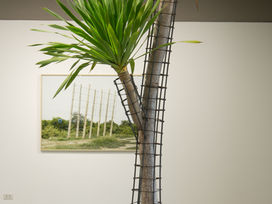informative to transformative
2 april – 3 july 2022
The ‘informative to transformative’ exhibition brings together a group of artists to seek out the milestones of humanity amidst nature in the modern age of mankind through sound installations comprised of field recordings by artist duo ADRUNNOGNT: Arnont Nongyao and Nguyen Ngoc Tu Dung, an on-going series of photographs from Atit Sornsongkram, a work of interactive installation art by ddmy studio, and a structural installation by Rodwiroon Wannakaew. Over the past several years, during the summer months - which began around March and ended in June - the province of Chiang Mai has been faced with a crisis of air pollution brought on by hazardous amounts of PM2.5 pollution. This was a result of the turbulent weather conditions, a sign of increased consumption among the masses, the cumulative result of the world’s shift into the age of humanity. These changes have slowly and inexorably made themselves known through their effects on our ways of life. The dust pollution affects not only the well-being of the area’s population, but the deteriorating air quality also influences our lives in the big picture - from social consensus and beliefs, the general motivation to live, to the culture and economy - nothing escapes the suffocating touch of the air, from the highest among us to the lowest. As a movement for environmental conservation brought on by the mounting pollution crisis, attempting to address the issues at their roots, the ‘informative to transformative’ exhibition sees the changing relationship between humanity and the physical properties of air. It is an effort to find a solution for the environmental problems that arose during this current age of humanity, presenting the issue in the context of Thai society - particularly that of Chiang Mai - to act as a milestone of the current time, marking the beginning of an effort to solve the problem of the environment through the examination of contemporary events. The ‘informative to transformative’ exhibition acts as a landmark to begin viewing the smog issue as a result of human actions by collectively exploring the expressive landscape of arts and culture, where the environment isn’t just a subject, but has taken root so deeply that it has become the very fabric of our beliefs and practices. The works include a photography series from Atit Sornsongkram, displayed throughout the exhibition space. His images of objects present the ambiguity between function and aesthetics, where an item’s existence progresses from man-made invention to a vague oddity whose function can no longer be discerned, yet still retains a physical allure. Located near Atit’s works is the installation art by ‘ddmy studio’, which invites audiences to take part in creating and collecting proof of our existence in a system that works in tandem with the exhibition space. The artist has designed a system that will record the data of people who have interacted with it, displaying the data on a monitor screen. The result is an ever-changing graphical representation of that data based on the amount and locations of participants, with the ultimate intention of decreasing the distance of communication in the case of fires in the deep forest. Meanwhile, Rodwiroon Wannakaew has layered the exhibition space with a structural installation piece. Known for his fascinating interpretation of the core concepts behind Thai idioms, as well as the traditional Thai belief in fortunes, into pieces of installation art. His interest in the subject of smog pollution arose during his time as a volunteer for reforestation efforts in areas of Chiang Mai devastated by forest fires. Lastly is the installation art created from field recordings by Arnont Nongyao, in collaboration with Nguyen Ngoc Tu Dung. Sixteen speakers are installed in a circle, each playing ambient sounds recorded from 16 different locations, creating a soundscape that ties all the other works together. The exhibition hopes to show a wider perspective on the environmental movement through artistic and cultural phenomena, with the environment and its surrounding topics acting as the leading subjects of interest. The works from each of the four artist groups - from photographs to installations - while different in form, conceptualization, and execution, are tied together with a methodology that demands searching for, exploration, curation, and recording to form works of art that represent the true thoughts and beliefs of artists. It can be considered a new way of bestowing an aesthetic significance, changing the process of creating art, while also perfectly encapsulating the current era of humanism. With the environment in its current urgent state, requiring immediate action, scientific date, and the cooperation of indigenous groups, signs point towards the end of Earth and humanity that is inevitable should humans continue to consume natural resources at its current rate of acceleration. According to the conclusions of Boris Groys, which states that the purpose of art is to present the various sides of life, a response to what the era of humanity calls for as proof of an artist’s existence. This response is the first signal that will send ripples throughout Thai society in regards to the immediate environmental perils facing the world, with each artist taking the first step towards addressing the issue by questioning the common rhetoric surrounding climate change, while also having the opportunity to reflect upon their own morality.







